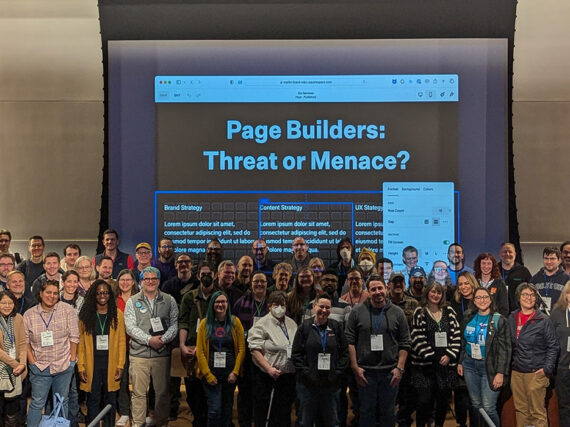In any user experience discovery effort, UX practitioners work to understand the scope and function of an application and its content to meet the needs of users. When an organization generates and updates webpages on an ongoing basis, the UX effort for content management system (CMS) implementations should include not only the end users (representing various audiences and demographics) but also the content managers and administrators of the site. Ultimately, we must seek to provide admins with an architecture that makes content creation as easy as possible.
At GovWebworks (GWW), we find that no matter how beautifully-crafted the end user experience is, if the admin experience is poor, it will ultimately fail, as it will handicap the individuals trying to use the platform to reach end users. We often hear of legacy systems that suffer from the following issues:
- Complicated or overwhelming for admins to learn
- Lacking necessary page features and components
- Required technical or coding skills to use
- Not set up to support the functionality needed
As a result, the organization becomes overly reliant on IT resources or the one or two publishers that know the system. This creates risk (think of the loss of critical knowledge due to turnover!) and can lead to inefficiencies, with bottlenecking and delays in content publishing as it awaits the attention of the few individuals who can work the system.
It is too often an afterthought to optimize the admin experience, when it should be a critical component of a successful CMS implementation. The UX effort must look into the future to set the administrators up for success with a new CMS. It’s not enough to simply map existing content into a new system, the best implementations analyze how to approach content creation and maintenance and anticipate future content needs.
What UX for a CMS should determine
When GovWebworks approaches a discovery and design phase for a Drupal CMS implementation, we work to understand the nature of the organization’s content needs. We typically conduct user research to have data-informed decisions incorporated into the site design. Our focus is on finding the best format, presentation, and organization of content to engage users, ensure findability, and create opportunities for self-service.
Additionally, we get to know the organization, uncovering details about who their content specialists are, how distributed or centralized their content management model may be, the number of contributors, and the organization’s governance needs. We also seek to understand the skills and expertise of content contributors. These inputs help us define the level of flexibility versus structure in the implementation.
Flexible admin
The most important consideration of a CMS implementation is how much flexibility to offer the organization’s content administrators. A highly flexible implementation offers content editors a large set of permissive, interchangeable UI components that can be mixed, matched, and resized to create almost infinite page layouts and displays. Pages created this way still follow brand guidelines and meet basic usability and accessibility requirements, but content creators have more control over page layouts. This experience is most beneficial to content managers who are:
- Creative and visual thinkers
- Comfortable building a page from a blank canvas
- Wanting the ability to create new layouts
The implementations we put together for this type of organization support easy rearrangement and resizing of sections, enabling a ‘trial and error’ approach to page creation. Organizations whose content is highly varied are best served with an implementation that offers the flexibility to build pages for a number of different needs. Especially if the content creators are familiar with Drupal’s Elementor tools, they will want to be able to use those tools to build pages with a variety of features.
Structured admin
On the other hand, a more structured implementation can help ensure consistency of content and a more straightforward approach to creating pages. A structured implementation is likely to utilize page templates and display types to make the site’s pages fit into pre-set layouts. This type of implementation takes the guesswork out of putting a page together, and may be less intimidating when new content is being created. It benefits content managers who are:
- Literal thinkers
- Wanting pages that follow a specific template
- Seeking a high level of predictability and consistency in presentation of their content
This approach results in less variety for the end user, which is often a benefit, but can force content managers into the constraints of a more rigid set-up. This implementation allows for more automation to prevent errors or miscommunication in the site as there are simply fewer choices or judgments for the content editor to make.
“Some clients prefer to have the guesswork taken out of page and content creation,” says Hellen Fitzpatrick, a GWW project manager with several Drupal implementations under her belt. “This allows them to better focus on the words and images of the content itself, without having to worry as much about how to format or structure it.”
How to decide
We cannot overstate the importance for organizations and software providers in putting consideration and analysis into the level of flexibility and structure that should form their CMS architecture. The wrong ‘fit’ can very negatively impact the organization, resulting in added costs associated with requests for changes (in an overly rigid implementation) or requests for more training and content support (in a very open implementation).
The good news is that it is a spectrum, and organizations working with a custom software developer can end up with a healthy mix of structure and flexibility that meets their needs. Sometimes the decision is not about going one way or the other, but how to blend the two.
“I’ve found many organizations can benefit from a combination of structured and fully flexible layout builder approaches so they can have control where needed, and flexibility and future-proofing where possible,” explains Adam Kempler, a senior Drupal developer at GWW.
“For example, the Missouri Department of Conservation wanted its Conservation Area pages to be highly consistent, so we created structured content types with specific required fields to be populated by content creators to achieve consistency in both the presentation and the scope of that content,” Kempler says.
“However, for the home page and general pages with more free-form content, they needed a layout builder approach that allows them to use a WYSIWYG to select from an assortment of pre-approved components and visually place them on the page where they want them. This enabled their site to accommodate changing and dynamic content on key pages.”
Governance and permissions
UX research is so crucial to finding just the right place on this spectrum for content managers. To determine the right fit, we often look at the role of governance and permissions at the organization
One of the primary considerations when deciding on the flexible-structured spectrum for your implementation is how content will be governed and how permissions will be distributed. Governance refers to the process or workflow the site content goes through between being drafted and being published.
You may find you can reap the benefits of a more flexible implementation for content creation when layering on governance workflows that introduce checks and controls to ensure the final, published product meets your organization’s brand and communication standards. Using governance workflows, newly created (or edited) content has to be reviewed by another user with approval or publishing permissions before it is made available to end users. Any issues with decisions made by the content creator during page creation can be detected and addressed before being a part of the publicly-accessed content.
Conversely, a more structured implementation of a CMS may reduce the need for strict content governance. As such, it allows for multiple content contributors, even if there are only a few with permissions to publish, to prevent bottlenecking of content and create distribution of responsibility for management of the site. A CMS implementation such as Drupal will provide robust capabilities for drafting and trying out content before it becomes published. It can offer more advanced controls like scheduled publications and removal of content, and can support editorial workflows to track content through the preparation into the published state.
Ultimately, the CMS can help an organization get away from their ‘legacy’ method of drafting content in an offline document often submitted via email to one of the few people who can actually implement changes. Instead they can use a friendly, highly integrated, customized CMS admin with a permissions scheme that fits the organization well.
It’s not one-size-fits-all
As we’ve discussed, there’s no single approach that is optimum for all CMS implementations. In actuality, the design and architecture of your content administration experience will depend on many factors, including:
- Size of the organization and number of content contributors
- Hierarchy and distribution of responsibility of the team members managing content
- Organizational preferences around control, flexibility, and autonomy
- Skills and experience level of the individuals involved
A vendor skilled in UX design will guide clients through the process of determining what the content management needs entail and how best to meet those needs on the spectrum of a flexible versus structured admin experience.
Organizations reap pay off in the long-term when they think about UX for admins upfront during the discovery, planning, and design of a project…rather than as an expensive afterthought.
Learn more
- Contact us for help with your content management needs
- Top 10 Most Effective UX Trends for 2021: Usability tips to make online life less stressful and easier to navigate, by Sarah Crossman
- What is the future of web content management? by Afoma Umesi, GatherContent Contributor, Writer







